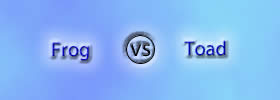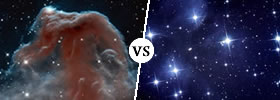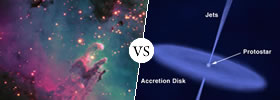Science & Mathematics
|
Supernovae is the plural form of supernova. They are the more brightening stars that signals the start of the end is known as supernovae. Black hole is an object with a gravitational field where gravity is so strong that not even light can escape. |
|
‘Nebula’ is a singular term, and ‘nebulae’ is a plural of nebula. Nebula is referred for extended objects consisting mostly of gas and dust. |
|
Nebula is a cloud in deep space consisting of gas or dirt/dust (e.g. cloud formed after a star explodes). A star is a luminous celestial body that has a spherical shape. It is made up of plasma, hydrogen, helium, etc. |
|
Nebula is a cloud in deep space consisting of gas or dirt/dust (e.g. cloud formed after a star explodes). Before the last sequence, a star has slender large amount of clouds of hydrogen, helium and dust, which is known as protostar. |
|
Pressure and Stress are two different types of forces that are constantly working against each other. Pressure is a type of external force that is exerted over a surface area of a material, whereas stress is a type of internal force that acts over a cross sectional area within the material. |
|
Falcons are birds of prey that have long pointed wings and an intended (concave) beak. Eagles are large birds of prey; they are known for their larger size. |
|
Kites are birds of prey; they tend to be smaller in size and weight less. Eagles are large birds of prey. |
|
Hawks are birds of prey that are usually smaller in size and have less weight. Falcons are birds of prey that have long pointed wings and an intended (concave) beak. |
|
Hawks are birds of prey that are usually smaller in size and have less weight. Vultures are large birds of prey. |
|
In philosophy of science, observation, theory and law, all play important roles. Observation is generally regarded as an act to sense the external real objects. Sense organs play a vital role in the observation. Theory can be described as a scientific explanation of an observed activity or a phenomenon. It explains the observations or events that are based upon any proven hypothesis. A law is a description of an observed phenomenon or activity. It is a statement of fact. |
|
Bacteria (singular: bacterium) are single celled micro-organisms and belong to the group of Prokaryotics. Microorganism refers to any of the organisms that can only be seen under a microscope. Therefore, bacteria are also micro-organisms. |
|
Bacteria are single celled microorganisms and belong to the group of Prokaryotics. A germ is a non medical term that is used to refer to a microorganism, especially the one that can cause any disease. Example of germs includes amoeba, fungus, bacteria, richetchia, virus, and so many others. |
|
Bacteria are single celled microorganisms and belong to the group of Prokaryotics. Algae (singular: alga) are Eukaryotic organisms (unicellular or multi-cellular) that contain chlorophyll and thus, carry out the process of photosynthesis. |
|
Bacteria are single celled and prokaryotic organisms. They can be harmful as well as beneficial; it depends upon the type of bacteria. On the other hand, Parasites are organisms that live in or on the hosts and derive their nourishment from the hosts. Bacteria are microscopic, whereas Parasites vary in sizes. |
|
|
Pages
 |
 |
 |
 |
 |
 |
 |
 |















